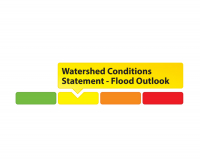March 9, 2020 (WCS – R03/2020) — The winter of 2019-20 has been warmer than average with near-average snowfall amounts. On January 11, about 50 mm of rain fell across the Rideau Valley Watershed, resulting in temporarily elevated water levels and flows in all waterways, and a noticeable ice layer within the snowpack. Current conditions at several RVCA and Parks Canada snow course sites are indicating above average water content amounts in the snow for this time of year.
The current short-term forecast indicates daytime high temperatures above zero and below zero conditions at night with precipitation expected tomorrow (up to 15 mm) and Friday (up to 20 mm). This forecast is favourable for ongoing snow melting. If the temperatures and precipitation come as forecast, much of the snow is expected to melt which will make water levels and flows rise over the coming weeks. This gradual process would result in average flooding this spring across the Rideau Valley watershed with inundation limited to low lying areas along all waterways. However, any significant rain events greater than 25 mm and/or significant temperature increases could influence actual flood conditions as we move through March and into April.
Water levels on lakes and flows in the streams are presently about normal for this time of year. Parks Canada staff who manage the water levels for the Rideau Canal have indicated that the levels will be maintained or lowered in the coming weeks to allow for water storage in the upper watershed lakes as the snowpack continues to melt.
City of Ottawa crews have begun the annual ice removal program on the Rideau River between Rideau Falls and Bronson Avenue. Crews will work to keep the ice from reforming until the spring freshet occurs (for more information: City of Ottawa information at 311).
With the changing levels that can be expected over the coming weeks, ice cover on lakes, ditches, local streams, and rivers will continue to be unstable. Extreme caution should be exercised by everyone when near local waterbodies. Parents should inform their children of the risks and provide appropriate supervision.
Residents in flood-prone or low-lying areas, historically susceptible to flooding, should take the necessary precautions to protect their property, such as:
- Ensuring sump pump is clear, in good working condition and has a backwater valve
- Ensuring easy access to a portable backup generator and pump
- Ensuring downspouts are clear and the outlet is at least 3 metres from the dwelling
- Securing items that might float away as flows increase
- Removing valuable items from basements or lower floors that could be subject to flooding
- Keeping emergency phone numbers handy
- Familiarizing yourself with your municipality’s Emergency Preparedness Plan
This watershed conditions statement is in effect until March 31, 2020, at 5 p.m. and will be updated at that time unless the forecast or conditions change.
"Rideau Valley Conservation Authority is a partnership of municipalities within the Rideau Valley watershed created under the Conservation Authorities Act to deliver a range of programs in watershed management and natural resource conservation."
RVCA Watershed Conditions Statements:
- Water Safety – High flows, unstable banks, melting ice or other factors that could be dangerous for recreational users such as anglers, canoeists, hikers, children, pets, etc. Flooding is not expected.
- Flood Outlook – Early notice of the potential for flooding based on weather forecasts, calling for heavy rain, snow melt, high winds or other conditions that could lead to high runoff, cause ice jams and/or lakeshore flooding or erosion.
- Flood Watch – Flooding is possible in specific watercourses or municipalities. Municipalities, emergency services and individuals in flood prone areas should prepare.
- Flood Warning – Flooding is imminent or already occurring in specific watercourses or municipalities.
